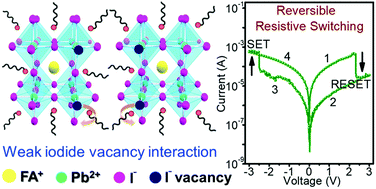Resistive switching in formamidinium lead iodide perovskite nanocrystals: a contradiction to the bulk form†
Abstract
Hybrid perovskites have emerged as an excellent class of materials for resistive random access memory (ReRAM) devices and neuromorphic computing applications. Among numerous perovskites, formamidinium lead triiodide (α-FAPbI3) is an important material due to its superior optoelectronic properties. However, it does not show resistive switching due to the difficulties in rupturing the filaments formed by iodide vacancies. Herein, we report the ReRAM device characteristics of α-FAPbI3 in the nanocrystal form, prepared in a single-step method. Unlike the bulk form, the nanocrystals show reliable, and reproducible memory characteristics in terms of program/erase operations, data retention, and endurance with an operating set voltage of around 2 V. Our studies revealed that the iodide vacancies are responsible for the switching and the presence of capping ligands plays a significant role in it. The capping ligands reduce the interaction energy between the iodide vacancies, and hence the filaments formed by the latter are easy to rupture during the reset process resulting in excellent ReRAM characteristics.



 Please wait while we load your content...
Please wait while we load your content...